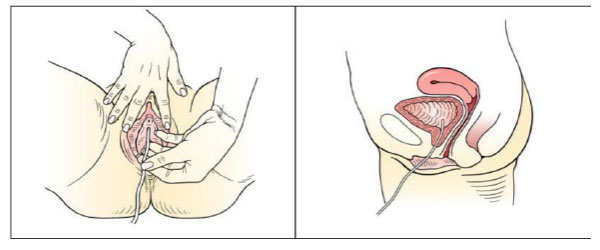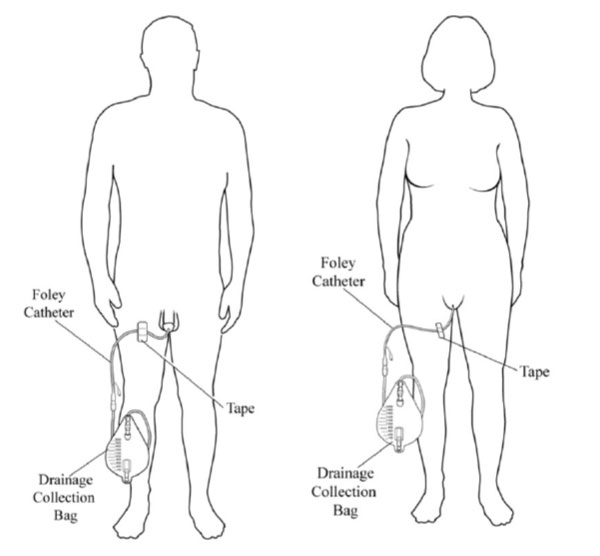There are 3 main ways that people with urinary retention caused by spinal cord injury may choose to manage their bladder:
Bridging patient centered outcomes research and improved clinical care.
Bridging patient centered outcomes research and improved clinical care.
Bridging patient centered outcomes research and improved clinical care.
Help me decide
Use our decision guide to help you determine what option is best for you.
A catheter is a small silicone or latex tube that is used to empty the bladder. Catheters can be passed into the bladder and kept only long enough to empty the bladder, usually less than a few minutes, this is called intermittent catheterization.
Indwelling catheters are catheters that are placed in the bladder for long periods of time (up to 1 month) before exchanging them. Indwelling catheters have a water filled balloon that floats in the bladder and keep the catheter from coming out. The balloon is deflated prior to removing the indwelling catheter. Indwelling catheters can be placed through the urethra (opening to bladder at the tip of the penis or vaginal area) or through a suprapubic tract (surgical connection between the bladder and the lower abdomen). Indwelling catheters that are passed through a suprapubic tract are called suprapubic tubes.
Clean intermittent catheterization (sometimes referred to as self-catheterization) is a way to empty your bladder using disposable catheters at home. People with spinal cord injury or their caregivers perform clean intermittent catheterization using clean supplies at regular intervals during the day. Usually, the bladder will need to be emptied at least every 4 hours while awake, but the exact period will be determined by your care team.
Intermittent catheters come in many sizes and designs to make them easy for people with spinal cord injury to use. There are reconstructive surgeries (see section titled “Reconstructive surgery”) that can help make intermittent catheterization easier for patients.
Some potential benefits of clean intermittent catheterization are:
Some potential harms of clean intermittent catheterization are:


Some people who cannot empty their bladder due to their spinal cord injury choose to have an indwelling catheter placed. Indwelling catheters can be placed through the urethra (called urethral catheters) or through a suprapubic tract in the lower abdomen (called suprapubic catheters). Indwelling catheters should be exchanged at least every 4 weeks with a new tube to avoid complications.
Suprapubic catheters are indwelling catheters that are placed through a connection between the skin in the lower part of the abdomen (suprapubic area) and the bladder.
The first time a suprapubic tube is placed, it must be placed through a surgery or procedure with anesthesia. After the procedure, the suprapubic catheter forms a tract between the bladder and the skin, like a piercing.
fter the first tube is in place it can be exchanged when you are awake by a nurse or caregiver. The exchanges take a few minutes and usually do not hurt. The suprapubic tube is a regular indwelling catheter. It is kept in place by a water filled balloon and it drains into a catheter bag.
The suprapubic tract usually closes on its own if the catheter is removed for long periods of time (more than 6 hours). Suprapubic indwelling catheters, rather than urethral indwelling catheters, are preferred for patients who choose a indwelling catheter as their bladder management strategy for the medium to long term (greater than 6 months).
Some potential benefits of suprapubic indwelling catheters are:
Some potential harms of suprapubic indwelling catheters are:
Urethral indwelling catheters are tubes that are passed through the urethra into the bladder in a sterile manner to avoid infections. After the catheter is in place, a small balloon on the tip of the catheter is filled with water, this balloon keeps the catheter from falling out.
The catheter is then connected to a drainage bag on the outside of the body. The urine that your body produces runs through the catheter into the drainage bag. The drainage bag needs to be emptied several times per day as it fills and cleaned regularly.

The drainage bag comes in small or large sizes, the smaller drainage bags can be hidden under clothing when in public.
The catheter and drainage bag should be exchanged at least once every 4 weeks. Urethral Indwelling catheters are recommended for the short term (less than 6 month) indwelling catheterization. People who choose an indwelling catheter for the long term (more than 6 months) may consider discussing suprapubic tube placement with their care team.
Some potential benefits of urethral indwelling catheters are:
Some potential harms of urethral indwelling catheters are:
Continent Catheterizable Channel: A surgery to make it easier to pass an intermittent catheter
Some people with spinal cord injury may not be able to perform intermittent catheterization through their urethra. This can happen if people require transfer to a bed and undressing to perform intermittent catheterization or if the urethra is difficult to catheterize due to pain or scarring. In these situations, a connection between the bladder and the skin of the abdomen can be made with a piece of intestine, that is disconnected from the gastrointestinal tract, so that patients with spinal cord injury can use intermittent catheterization. This surgery is called a “continent catheterizable channel.” If the appendix is used, it is sometimes called an ”appendicovesicostomy” or “mitrofanoff” procedure. These are major abdominal surgeries that require a hospitalization for 3-7 days and have a 6 week recovery period.
Augmentation Cystoplasty: A surgery to increase the amount of urine a bladder can safely hold
Some people with spinal cord injury can experience changes to the size and function of their bladder. Sometimes the bladder can become small and does not hold urine well. Small bladders can leak urine between intermittent catheterizations. There are medications taken by mouth or injected into the bladder wall that can help the bladder hold more urine. In some cases, these medications are not enough and surgery can help the bladder hold more urine. This surgery is called augmentation cystoplasty. Augmentation cystoplasty is performed by taking a piece of intestine, that is disconnected from the gastrointestinal tract, and using it to make the bladder bigger. These are major abdominal surgeries that require a hospitalization for 3-7 days and have a 6 week recovery period. Augmentation cystoplasty can be performed with or without the creation of a continent catheterizable channel (see section “continent catheterizable channel”). People with augmentation cystoplasty usually still catheterize and also require regular irrigation (washing of the bladder with saline or water) of the bladder to clear mucous that is produced by the intestine.
Cystectomy and urinary diversion: A surgery to remove the bladder and reroute the urine
Some people with spinal cord injury that experience changes to the size and function of their bladder that cannot be managed effectively with catheters or medications or augmentation cystoplasty. In these cases, the bladder can be removed, in a surgery called a “cystectomy.” The urine is rerouted, called a urinary diversion, through a piece of intestine, that is disconnected from the gastrointestinal tract, to an opening on the skin of the abdomen (called a urostomy or stoma). A temporary bag is then adhered to the skin of the abdomen to collect the urine. No catheterization is required, though the bag is emptied regularly and must be completely changed at regular intervals. More information about this procedure is available in the handout called “Urostomy Patient Handbook”
Click through this section to compare each catheter option
| Type of Catheter | Description |
|---|---|
| Clean Intermittent Catheterization |
|
| Suprapubic Indwelling Catheter |
|
| Urethral Indwelling Catheter |
|
| Type of Catheter | Description |
|---|---|
| Clean Intermittent Catheterization |
|
| Suprapubic Indwelling Catheter |
|
| Urethral Indwelling Catheter |
|
| Type of Catheter | Description |
|---|---|
| Clean Intermittent Catheterization |
|
| Suprapubic Indwelling Catheter |
|
| Urethral Indwelling Catheter |
|
| Type of Catheter | Description |
|---|---|
| Clean Intermittent Catheterization |
|
| Suprapubic Indwelling Catheter |
|
| Urethral Indwelling Catheter |
|
| Type of Catheter | Description |
|---|---|
| Clean Intermittent Catheterization |
|
| Suprapubic Indwelling Catheter |
|
| Urethral Indwelling Catheter |
|
| Type of Catheter | Description |
|---|---|
| Clean Intermittent Catheterization |
|
| Suprapubic Indwelling Catheter |
|
| Urethral Indwelling Catheter |
|
| Type of Catheter | Description |
|---|---|
| Clean Intermittent Catheterization |
|
| Suprapubic Indwelling Catheter |
|
| Urethral Indwelling Catheter |
|
| Type of Catheter | Description |
|---|---|
| Clean Intermittent Catheterization |
|
| Suprapubic Indwelling Catheter |
|
| Urethral Indwelling Catheter |
|
| Type of Catheter | Description |
|---|---|
| Clean Intermittent Catheterization |
|
| Suprapubic Indwelling Catheter |
|
| Urethral Indwelling Catheter |
|
| Type of Catheter | Description |
|---|---|
| Clean Intermittent Catheterization |
|
| Suprapubic Indwelling Catheter |
|
| Urethral Indwelling Catheter |
|
| Type of Catheter | Description |
|---|---|
| Clean Intermittent Catheterization |
|
|
Suprapubic Indwelling Catheter and Urethral Indwelling Catheter |
|
| Type of Catheter | Description |
|---|---|
| Clean Intermittent Catheterization |
|
| Suprapubic Indwelling Catheter |
|
| Urethral Indwelling Catheter |
|
| Type of Catheter | Description |
|---|---|
| Clean Intermittent Catheterization |
|
|
Suprapubic Indwelling Catheter and Urethral Indwelling Catheter |
|
| Type of Catheter | Description |
|---|---|
| Clean Intermittent Catheterization |
|
| Suprapubic Indwelling Catheter |
|
| Urethral Indwelling Catheter |
|